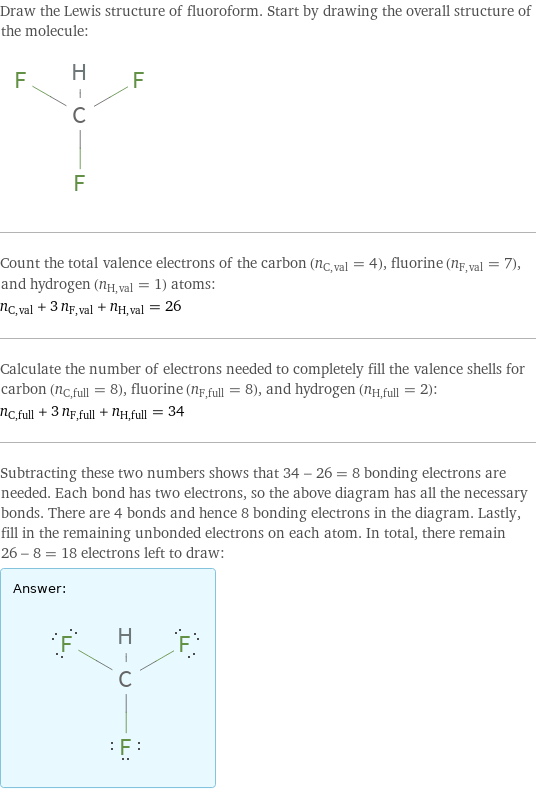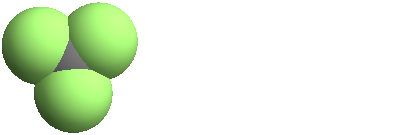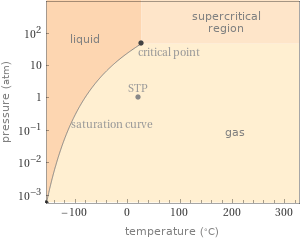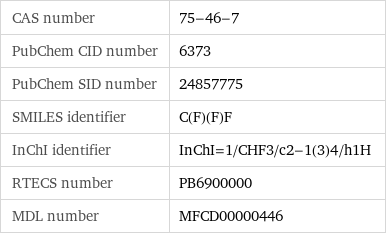Input interpretation

fluoroform
Chemical names and formulas

formula | CHF_3 name | fluoroform alternate names | carbon trifluoride | fluoryl | Freon 23 | halocarbon 23 | HFC-23 | methane, trifluoro | methane, trifluoro- | methyl trifluoride | R-23 | trifluoromethane mass fractions | C (carbon) 17.2% | F (fluorine) 81.4% | H (hydrogen) 1.44%
Lewis structure

Draw the Lewis structure of fluoroform. Start by drawing the overall structure of the molecule: Count the total valence electrons of the carbon (n_C, val = 4), fluorine (n_F, val = 7), and hydrogen (n_H, val = 1) atoms: n_C, val + 3 n_F, val + n_H, val = 26 Calculate the number of electrons needed to completely fill the valence shells for carbon (n_C, full = 8), fluorine (n_F, full = 8), and hydrogen (n_H, full = 2): n_C, full + 3 n_F, full + n_H, full = 34 Subtracting these two numbers shows that 34 - 26 = 8 bonding electrons are needed. Each bond has two electrons, so the above diagram has all the necessary bonds. There are 4 bonds and hence 8 bonding electrons in the diagram. Lastly, fill in the remaining unbonded electrons on each atom. In total, there remain 26 - 8 = 18 electrons left to draw: Answer: | |
3D structure

3D structure
Basic properties

molar mass | 70.014 g/mol phase | gas (at STP) melting point | -160 °C boiling point | -84 °C solubility in water | insoluble dielectric constant | 1.007
Gas properties (at STP)

vapor density | 2.43 (relative to air) refractive index | 1.00043 dynamic viscosity | 1.491×10^-5 Pa s (at 25 °C)
Units

Thermodynamic properties

specific heat capacity c_p | gas | 0.7284 J/(g K) molar heat capacity c_p | gas | 51 J/(mol K) specific heat of formation Δ_fH° | gas | -9.932 kJ/g molar heat of formation Δ_fH° | gas | -695.4 kJ/mol molar heat of vaporization | 16.7 kJ/mol | specific heat of vaporization | 0.2385 kJ/g | molar heat of fusion | 4.06 kJ/mol | specific heat of fusion | 0.057988 kJ/g | critical temperature | 300 K | critical pressure | 4.795 MPa | (at STP)
Phase diagram

Phase diagram
Units

Chemical identifiers

CAS number | 75-46-7 PubChem CID number | 6373 PubChem SID number | 24857775 SMILES identifier | C(F)(F)F InChI identifier | InChI=1/CHF3/c2-1(3)4/h1H RTECS number | PB6900000 MDL number | MFCD00000446
NFPA label

NFPA label

NFPA health rating | 2
Safety properties

flash point | -112 °C upper explosive limit | 35.3% (concentration in air)

DOT hazard class | 2.2 DOT numbers | 3136
Toxicity properties

odor | odorless

RTECS classes | mutagen